
| Home |
| Intro |
| Current Issue |
| Mailing List |
| Store |
| Strength |
| Subscriber Content |
| ARCHIVES REVIEWS |
| Martialism |
| Pacifism |
| Q & A |
| Cunning-Hammery |
| Advertise With Us |
| Submit An Article |
| Staff |
| Discussion Forum |
| Links |
"Stay 'unreasonable.' If you
don't like the solutions [available to you], come up with your
own."
Dan Webre
The Martialist does not
constitute legal advice. It is for ENTERTAINMENT
PURPOSES ONLY.
Copyright © 2003-2004 Phil Elmore, all rights
reserved.
Using Your Torch for Self-Defense
By Phil Elmore
The utility value of having a bright, handheld light source on you at all times is fairly obvious – whenever you need illumination, you have it. I've used my daily carry torch to illuminate the back of my computer and the underside of my desk while connecting cables, to navigate darkened movie theaters (I almost blinded myself switching it on to make sure my phone was switched off during Spiderman 2), to safely cross streets at night in various cities, and to check the corners of hotel rooms to make sure I was leaving behind no stray socks or keys. The really neat thing about sturdy handheld torches, however, is that they can serve as expedient striking implements. You can use them as you would any pocket stick. While most torches are a little shorter than many pocket sticks, the difference isn't that great.
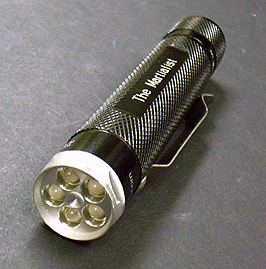
Author's discontinued NightCutter 5PC torch.
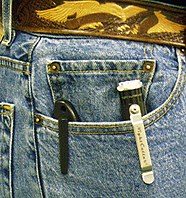 Now,
I have to state up front that most torch manufacturers don't market their lights as
striking tools. I am also not encouraging you to use them as such
– I can't give you legal advice and you can't take this article as license to go
out and start beating on people with flashlights. The fact is, though,
that it's an aluminum cylinder with a raised head that leaves a
circular welt when you use it to hit a
soft target. If that's not an expedient self-defense tool, well... neither
is a sturdy metal fountain pen.
Now,
I have to state up front that most torch manufacturers don't market their lights as
striking tools. I am also not encouraging you to use them as such
– I can't give you legal advice and you can't take this article as license to go
out and start beating on people with flashlights. The fact is, though,
that it's an aluminum cylinder with a raised head that leaves a
circular welt when you use it to hit a
soft target. If that's not an expedient self-defense tool, well... neither
is a sturdy metal fountain pen.
Given the shorter length of the light, I believe the best way to use it is with simple hammer-fist blows, delivered in rapid succession in combination with the "live" hand to guard and perhaps eye-flick as the light is driven repeatedly into an assailant. The strongest grip is the simple clenched fist (below, left), while activating the light requires you to deliver strikes with your thumb capping the tail switch. Be advised that hitting something with your thumb in that position increases slightly the danger of injuring your thumb if you strike an unyielding surface. You'd have to be striking very hard for this to be an issue, though, provided your fingers have a good grip on the barrel of the light.
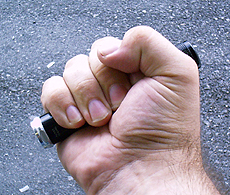
Simple clenched fist grip.
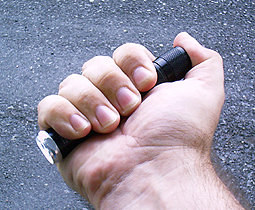
Using the thumb to activate the tailcap.
Those of you who do pikal knife jabs will find the mechanics of this extremely natural. Anyone with FMA experience will probably think it's intuitive, too. As you draw your light with your strong hand, your off hand comes forward to protect your body. As the light is used to deliver a hammer blow (overhand or as a backhand) it comes over or under the off hand and the two rotate each other as you ruin your attacker's day.
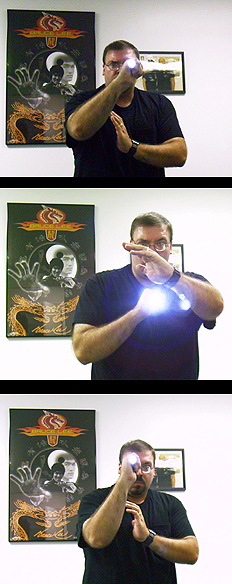
Strikes reciprocating over (or under) the
off hand, which comes forward as
the light comes back.
Carrying a light like this is also very adaptable to the sorts of personal space body mechanics that The Martialist recommends if you have the time and the room in which to invoke them. From whatever casual ready stance you use – say, a "Jack Benny" stance with your hand on your chin – you can move to a hands-up ready stance and draw your light as you make the transition to a more aggressive posture to counter or preempt your assailant.
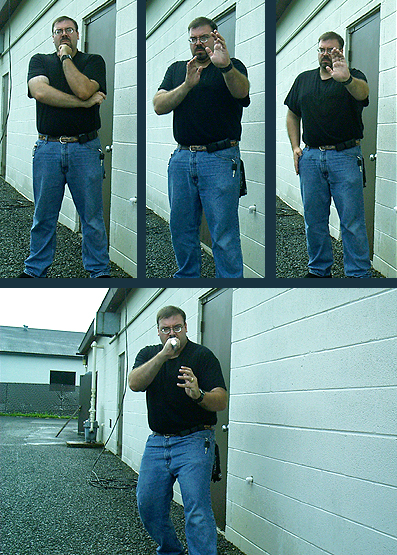
Moving from ready stance to hands-up to light deployed.
If you choose to trigger the light in low-light conditions, you can probably gain a little by distracting your assailant. A diode or a Xenon bulb powered by one or two CR123A lithium batteries is not exactly the power of the sun in the palm of your hand – but it's not something I'd want to stare into all day, much less suddenly with my pupils dilated. Use your head. If you can deploy the light to your advantage while using it to strike, great.
To practice using the light begs a little roleplay. If you have access to a padded partner, so much the better. (I wouldn't recommend finding a friend and then pounding away on him with the end of a NightCutter or other light.) I took some shots practice on the trusty Body Opponent Bag (BOB). Starting from a casual stance, you can move to a "fence" or hands-up stance while using the appropriate, "Hey, nobody wants any trouble" body language and verbal de-escalation techniques. From there you can choose a point at which you must preempt Bob's attack. Teach his rubbery ass (well, okay, he hasn't really got one) a lesson.
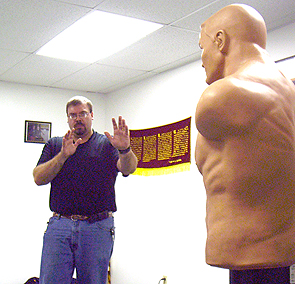
"Who, there, Bob, I wasn't hitting on your air shield.
She means nothing to me. Let's not get rowdy."
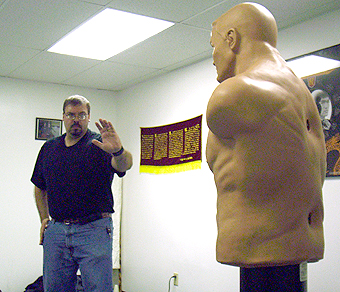
"That's far enough, Bob. Don't advance on me."
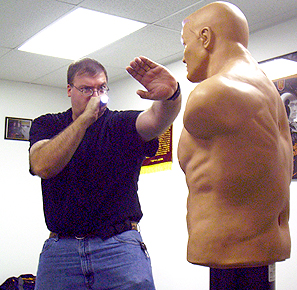
Eye flick or bil jee followed by...
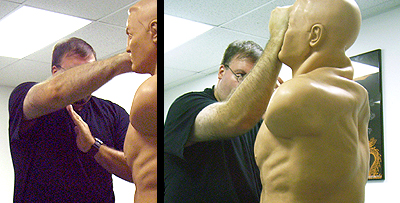
Repeated strikes to the face using the head of the
light.
Now, before I get accused of commercialism run amok, it should be obvious that these are simple techniques you can use with any light, pocket stick, or other sturdy cylindrical object. On my keychain I always carry a pocket stick of some kind, with my car key hanging out of my pocket to facilitate drawing the stick. I use the same technique but with my left hand (because that's the side on which I carry my keys).
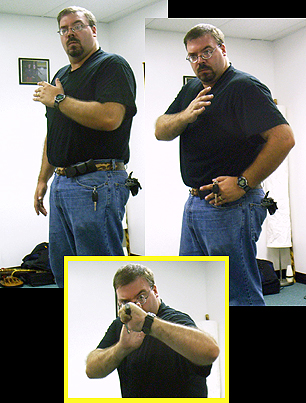
Drawing a keychain pocket stick for use in defense.
Having an implement that is much stronger than your hand with which to concentrate the force of a hammer blow into a smaller area is... well, a really great thing when it comes to delivering force for self-defense. The first rule of using any tool in this capacity is to have the tool. Making the decision to carry a tactical light means you'll have it when you need it.
That's planning ahead.